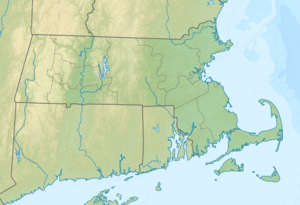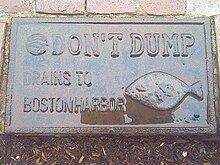Boston Harbor
| Boston Harbor | ||
|---|---|---|
| Waters | Massachusetts Bay | |
| Land mass | New England ( North America ) | |
| Geographical location | 42 ° 20 ′ N , 71 ° 0 ′ W | |
|
|
||
| width | approx. 20 km | |
| depth | approx. 8 km | |
| Tributaries | Mystic River , Charles River , Neponset River | |
Boston Harbor is a natural harbor basin near Boston , Massachusetts . It houses the Port of Boston , a major cargo port in the northeastern United States . Boston Harbor has been one of the most important ports in US history since it was discovered by the adventurer John Smith in 1614. In the period around 1660 it served as the main import port for English merchant shipping, it was the scene of the Boston Tea Party and experienced continuous replenishment for the purpose of land reclamation into the 19th century .
geography
Boston Harbor is a large natural harbor that forms the far west of Massachusetts Bay . Thanks to the Winthrop Peninsula and Deer Island in the north, Nantasket Peninsula and Point Allerton in the south and the harbor islands in the middle, the harbor is shielded from Massachusetts Bay and the Atlantic Ocean. Geographically, the area can be divided into an outer and an inner harbor.
Port islands
Boston Harbor encompasses a substantial number of islands, 34 of which are part of the Boston Harbor Islands National Recreation Area . The following islands are located within the harbor basin:
- Bumpkin Island , Button Island
- Castle Island
- Calf Island
- Gallops Island , Georges Island , Grape Island , Great Brewster Island , Green Island
- Hangman Island
- Langlee Island , Little Brewster Island , Little Calf Island , Long Island , Lovells Island
- Middle Brewster Island
- Moon Island , Mermaid's Mate
- Outer Brewster Island
- Peddocks Island
- Raccoon Island , Ragged Island , Rainsford Island
- Sarah Island , Shag Rocks , Sheep Island , Slate Island , Snake Island , Spectacle Island , Spinnaker Island
- The Graves , Thompson Island
Castle Island and Deer Island still exist in a recognizable form and are labeled "Island" but are no longer to be considered as such. Castle Island was connected to the mainland through land reclamation, and Deer Island has not been an island since the 1938 New England Hurricane filled in the channel that separated it from the mainland. Nut Island, a small island in Boston Harbor, was connected to the Hough's Neck Peninsula by replenishment in the 1940s and a sewage treatment plant was built on it. Two other islands, Apple Island and Governors Island , were raised for the construction of Logan International Airport .
Environmental and health problems
The intensive use of the area by industry and trade resulted in a corresponding pollution of the environment with an impact on public health. The first U.S. law to protect the environment was passed in Boston in 1656. It banned butchers from throwing their slaughterhouse waste and other rubbish into the port waters. The outbreak of typhus in 1796 was attributed to the polluted harbor waters. In 1850 the first comprehensive draft of a law to protect public health was drawn up. He attributed the high mortality rate among immigrants to the poor hygienic conditions. It also made recommendations on the use of organic waste as fertilizer in agriculture, one of the early examples of recycling and waste recovery.
Early attempts at improvement
In the second half of the 19th century a bathing ban was imposed over Boston Harbor for fear of ulcers, because the harbor basin was still a sewer. After a cholera epidemic , voices were raised from the population in 1863 calling for an improved sewer system. In 1889 the first steam-powered sewage pumping station was built in East Boston , and a second was put into operation in 1899 on Deer Island . It was hoped that these systems would significantly improve the water quality, but they only filtered out large objects and led the remaining wastewater back into the basin practically untreated.
Metropolitan District Commission
In 1919, the Metropolitan District Commission (MDC) was created to manage the area's sewage and sewer systems. The government-funded commission was responsible for the three pumping stations, East Boston, Deer Island, and Nut Island , but had insufficient funds to do the job. In 1939, the legislature published a report on the disastrous condition of the harbor basin and recommended a $ 24 million project to address the environmental problems in Hingham Bay and Quincy Bay.
The MDC built a wastewater treatment plant on Deer Island in 1968 , which was in operation until the start of the Boston Harbor Project in 1995. The systems circulated around 1.3 billion liters of water every day, but only ten percent of the pollution was actually filtered out. The resulting sewage sludge was pumped directly into the harbor basin via a digestion tower , as it was believed that the current would carry all residues out into the sea.
The Clean Water Act
The 1972 Clean Water Act required a second treatment process for all wastewater treated by municipal purification plants. The ordinance granted exemptions for coastal cities and Boston made an application, which was rejected. At the time, Boston Harbor was in its worst shape ever and should have needed additional clarification, but the environmental protection agency and city council ignored Boston's environmental concerns.
Governor Dukakis
Michael Dukakis served as governor of Massachusetts for two terms. When asked about the Boston Harbor environmental problem, Dukakis said that he was not the one who polluted the Harbor, but the one who wanted to clean it up. This argument, however, contradicted Boston's motion for an exemption from the Clean Water Act of 1972.
Court cases
Unsatisfied with the fact that no steps had been taken by the public to clean up and clear Boston Harbor, individuals and organizations took legal action against those responsible. The City of Quincy's lawsuit against the MDC for water pollution was ultimately followed by a landmark ruling by the US federal government against the State of Boston, according to which Boston Harbor had to undergo extensive cleaning and clarification. This court ruling forced then governor Michael Dukakis in 1985 to spin off the sewage and sewerage divisions from the MDC and transfer them to the newly created Massachusetts Department of Water Management . The cleaning project continues to this day.
Pop Culture
The garage rock band The Standells wrote the song Dirty Water in 1966 , which denounced the poor water quality of the Charles River . The song is still popular with Red Sox fans and is played regularly at Fenway Park Stadium .
The plot of the thriller "Zodiac" (1988, also: "Zodiac: The Eco-Thriller", Eng. "Volles Rohr") by Neal Stephenson plays in the dispute between environmentalists and chemical companies about the water quality of Boston Harbor.
Boston Harbor as an election issue
The court-ordered cleaning project with its hesitant progress even became a campaign issue during the presidential elections in 1988 , when George Bush senior. partly because of his campaign speeches that challenged Dukakis' environmental program against his rival.
"Boston Harbor Project"
The Boston Harbor Project included a large Deer Island Sewerage Treatment Plant on Deer Island and funding for studies and records of water quality. It was started in 1985 and was completed in 2001. Today, this wastewater treatment is state of the art.
Web links
- Official website of the Boston Harbor
- Website of the community of interests for the protection of Boston Harbor

